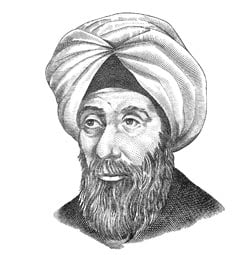A millennium ago, an Arab scientist authored more than 100 works on optics, astronomy, mathematics and religious philosophy. Although he was arguably one of the greatest scientists of all time, his name is little known to people living in Western countries today.
He is sometimes referred to by his last name, ibn al-Haytham, but he is most often called by his first name, Alhazen, although historians have noted that his first name is more accurately translated to al-Hasan or Abu Ali al-Hasan.
Alhazen was born in Basra in what is now Iraq in the year 965 and died around 1040. Although he was born in Basra, he lived most of his life in what is now called Cairo, Egypt. While Europeans languished in the Dark Ages, the Arabs were experiencing their Golden Age, and Alhazen is the most celebrated scientist of that time.
 His most famous work, Book of Optics, was translated into Latin and disseminated throughout Europe in the Middle Ages. This work influenced many great thinkers, including Roger Bacon, who wrote a summary of it. In this book, Alhazen correctly identified that eyesight is caused by light entering the eye, contradicting an earlier belief espoused by Euclid and Ptolemy that light is emitted from the eye.
His most famous work, Book of Optics, was translated into Latin and disseminated throughout Europe in the Middle Ages. This work influenced many great thinkers, including Roger Bacon, who wrote a summary of it. In this book, Alhazen correctly identified that eyesight is caused by light entering the eye, contradicting an earlier belief espoused by Euclid and Ptolemy that light is emitted from the eye.
In what is known as Alhazen’s problem, he also used conic sections to determine the point of reflection from a surface given the center of the eye and the observed point. He described a pinhole camera and the camera obscura.
Alhazen also described the refraction and the dispersion of light into its component colors, ideas credited to Isaac Newton. “Certainly in the field of optics, Newton himself stood on the shoulders of a giant who lived 700 years earlier,” said Jim Al-Khalili, a physics professor at the University of Surrey in the UK. Khalili recently narrated “The Empire of Reason,” a BBC program on Alhazen that is part of a three-part series on medieval Islamic scientists.
Alhazen also described the motion of the planets, which inspired Johannes Kepler. Alhazen was perhaps the first person to use the scientific method. Author Bradley Steffens calls him “the first scientist.”
But Alhazen did have a low point in his career. He became overconfident and bragged that he could regulate the floods of the Nile. The ruler of the land, who was known as the Mad Caliph, heard this boast and ordered Alhazen to make good on it. Realizing that he faced an impossible task and fearing the punishment of the caliph, Alhazen feigned madness and was placed under house arrest from 1011 until the caliph’s death in 1021. House arrest was a blessing in disguise because it gave him time to do his experiments and write books, including his famous book on optics.
Alhazen, the great Arab scientist, made many contributions to optics.